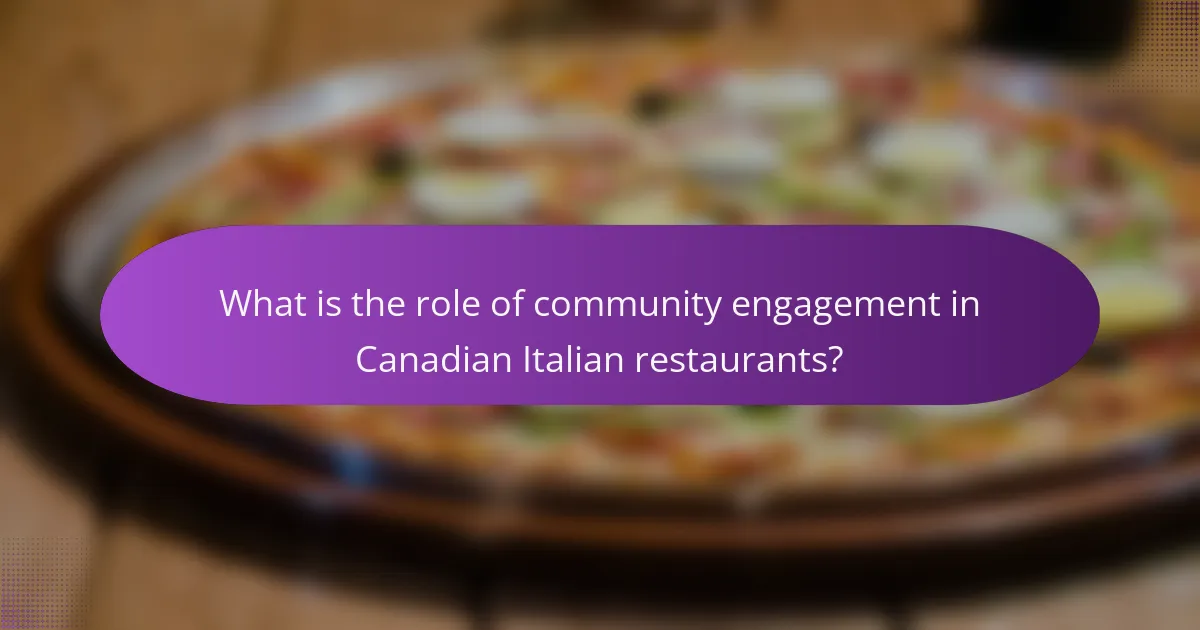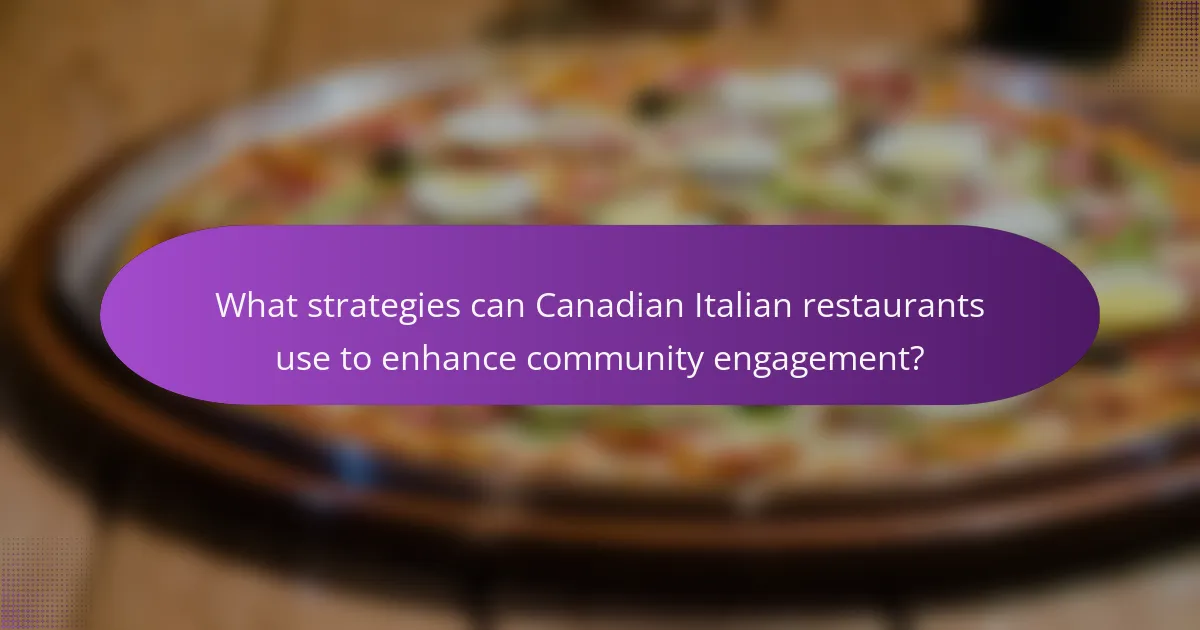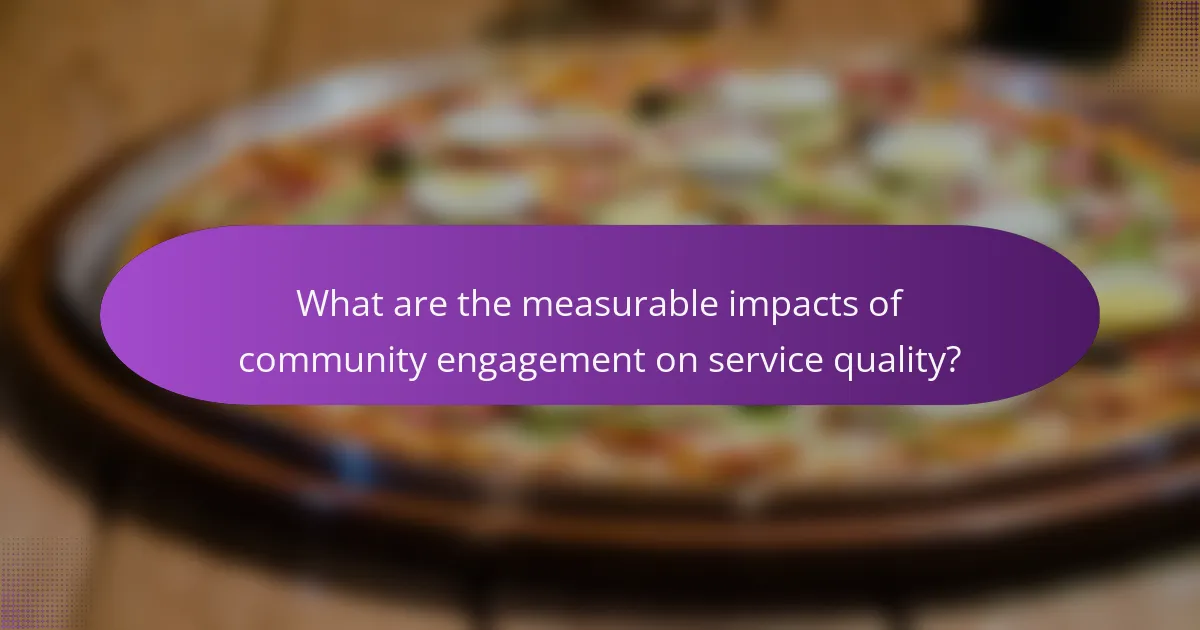
What is the role of community engagement in Canadian Italian restaurants?
Community engagement in Canadian Italian restaurants enhances service quality and fosters loyalty. It allows restaurants to build relationships with local customers. Engaging with the community helps restaurants understand customer preferences. This understanding can lead to menu adjustments that reflect local tastes. Participation in community events increases visibility and brand recognition. It also encourages customer feedback, leading to improved services. For example, many Canadian Italian restaurants host local events or collaborate with nearby businesses. This not only strengthens community ties but also attracts new patrons. Overall, community engagement is essential for the success and sustainability of Canadian Italian restaurants.
How does community engagement influence service quality?
Community engagement significantly enhances service quality at Canadian Italian restaurants. Engaged communities provide valuable feedback that helps restaurants improve their offerings. This interaction fosters a sense of loyalty among customers. Research shows that restaurants with high community involvement report better customer satisfaction scores. Additionally, community events can increase visibility and attract new patrons. Engaging with local suppliers also improves ingredient quality, directly affecting dishes served. In summary, community engagement creates a feedback loop that benefits both the restaurant and its customers.
What are the key elements of community engagement in this context?
Key elements of community engagement in this context include active participation, collaboration, and communication. Active participation involves community members contributing their ideas and feedback. Collaboration occurs between restaurants and local organizations to foster partnerships. Effective communication ensures transparency and builds trust among stakeholders. Additionally, cultural relevance is crucial, as it aligns restaurant offerings with community preferences. Lastly, ongoing evaluation helps assess the impact of engagement efforts. These elements collectively enhance service quality and customer satisfaction at Canadian Italian restaurants.
How does community engagement impact customer satisfaction?
Community engagement significantly enhances customer satisfaction. Engaged communities foster a sense of belonging among customers. This connection leads to loyalty and repeat business. Research shows that businesses with strong community ties see a 20% increase in customer satisfaction. Engaged customers feel valued and heard, which improves their overall experience. Additionally, community events create opportunities for direct interaction between customers and businesses. This interaction builds trust and transparency, further boosting satisfaction levels. In the context of Canadian Italian restaurants, community engagement can lead to tailored services that meet local preferences. This alignment with customer needs directly correlates with higher satisfaction rates.
Why is community engagement important for Canadian Italian restaurants?
Community engagement is important for Canadian Italian restaurants because it fosters customer loyalty and enhances brand reputation. Engaged communities are more likely to support local businesses. This support can lead to increased foot traffic and sales. Additionally, community involvement allows restaurants to build relationships with local suppliers. These relationships can improve ingredient quality and authenticity. Participating in local events also raises awareness of the restaurant. Studies show that community-oriented businesses experience higher customer retention rates. For example, restaurants that engage in community events often see a 20% increase in repeat customers.
What benefits does community engagement provide to restaurant owners?
Community engagement provides several benefits to restaurant owners. It enhances brand loyalty among customers. Engaged communities are more likely to support local businesses. This can lead to increased foot traffic and higher sales. Additionally, community engagement fosters positive word-of-mouth marketing. Satisfied customers often share their experiences with others. This can expand the restaurant’s reach and attract new patrons. Engaging with the community also helps restaurant owners understand customer preferences. This insight can inform menu development and service improvements. Overall, community engagement strengthens the restaurant’s reputation and financial performance.
How does community engagement enhance the dining experience?
Community engagement enhances the dining experience by fostering a sense of belonging among patrons. When restaurants actively involve local residents, they create a welcoming atmosphere. This engagement often leads to personalized service tailored to community preferences. It can also result in unique menu offerings that reflect local tastes. Studies show that restaurants with strong community ties experience higher customer loyalty. Engaged customers are more likely to return and recommend the establishment. Additionally, community events can attract new customers and create buzz. Overall, community engagement enriches the dining experience by building relationships and enhancing customer satisfaction.

What strategies can Canadian Italian restaurants use to enhance community engagement?
Canadian Italian restaurants can enhance community engagement through local partnerships and events. Collaborating with local farms for fresh ingredients fosters community ties. Hosting cooking classes or wine tastings encourages interaction and education. Participating in community festivals showcases the restaurant’s culture. Offering loyalty programs rewards local customers, strengthening relationships. Supporting local charities through fundraising events builds goodwill and visibility. Engaging on social media allows direct communication with the community. These strategies create a sense of belonging and loyalty among patrons.
How can restaurants effectively connect with their local community?
Restaurants can effectively connect with their local community by engaging in community events and supporting local initiatives. They can host fundraisers for local charities or participate in farmers’ markets. Offering locally sourced ingredients fosters relationships with local suppliers. Collaborating with nearby businesses for joint promotions can enhance visibility. Creating a welcoming atmosphere encourages community gatherings. Providing cooking classes or workshops can educate and engage locals. Utilizing social media to share community stories builds a stronger connection. Research shows that community engagement leads to increased customer loyalty and satisfaction.
What role do events and promotions play in fostering community ties?
Events and promotions play a crucial role in fostering community ties. They create opportunities for social interaction among community members. Such gatherings encourage networking and relationship building. Events often highlight local culture and traditions, enhancing community identity. Promotions can attract diverse groups, increasing participation and inclusivity. Research shows that community events can boost local business engagement. For example, a study by the National Endowment for the Arts found that community events increase social cohesion. This cohesion leads to stronger support networks within the community. Overall, events and promotions significantly contribute to community bonding and engagement.
How can social media be utilized to boost community engagement?
Social media can be utilized to boost community engagement by fostering direct communication between restaurants and their patrons. Engaging content, such as polls and questions, encourages interaction. Sharing user-generated content creates a sense of community and belonging. Hosting virtual events or live cooking classes invites participation and strengthens connections. Regular updates about menu changes and community events keep patrons informed and involved. Responding to comments and messages builds trust and loyalty among customers. According to a survey by Sprout Social, 64% of consumers want brands to connect with them on social media. This shows that active engagement can enhance customer relationships and service quality.
What are the challenges faced in community engagement?
Community engagement faces several challenges. One significant challenge is lack of participation. Many community members may not feel motivated to engage. This can stem from a perceived lack of relevance or interest in the issues at hand. Another challenge is communication barriers. Misunderstandings can arise due to language differences or varying levels of education. Additionally, trust issues can hinder engagement. Communities may be skeptical of organizations or initiatives based on past experiences. Resource limitations also pose a challenge. Many community groups operate with limited funding and manpower. This restricts their ability to reach out effectively. Finally, diverse perspectives can complicate consensus-building. Different opinions on priorities can lead to conflicts and slow progress. Addressing these challenges is vital for effective community engagement.
How can restaurants overcome barriers to effective community engagement?
Restaurants can overcome barriers to effective community engagement by actively participating in local events. Engaging in community activities fosters relationships with residents. Collaborating with local organizations enhances visibility and trust. Offering promotions or discounts to community members can encourage patronage. Utilizing social media platforms allows for direct communication with customers. Hosting community meetings can gather feedback and input from locals. Training staff on cultural sensitivity improves interactions with diverse community members. These strategies have been shown to create a sense of belonging and loyalty among patrons.
What are common misconceptions about community engagement in restaurants?
Common misconceptions about community engagement in restaurants include the belief that it is solely about marketing. Many think that community engagement is just a promotional tool. However, it involves building genuine relationships with local patrons. Another misconception is that only large restaurants can engage effectively. In reality, small establishments can also create significant community ties. Some believe that community engagement requires extensive resources. Yet, even simple initiatives can foster connection and loyalty. Additionally, there is a notion that engagement is a one-time effort. In truth, it requires ongoing commitment and interaction to be effective. Lastly, some assume that community engagement does not impact service quality. Research shows that engaged restaurants often see improved customer satisfaction and loyalty.

What are the measurable impacts of community engagement on service quality?
Community engagement significantly enhances service quality in Canadian Italian restaurants. Engaged communities contribute valuable feedback and insights. This feedback leads to improved menu offerings and tailored services. Studies indicate that restaurants with strong community ties report higher customer satisfaction. For instance, a survey by the Restaurant Association found that 75% of patrons prefer businesses that support local initiatives. Additionally, community involvement fosters a sense of belonging. This creates loyal customers who return frequently. Engaged customers are also more likely to recommend the restaurant to others. Overall, community engagement directly correlates with measurable improvements in service quality.
How can restaurants assess the effectiveness of their community engagement efforts?
Restaurants can assess the effectiveness of their community engagement efforts through various metrics. They can analyze customer feedback collected via surveys and social media interactions. Tracking participation rates in community events provides insights into engagement levels. Monitoring changes in customer demographics can indicate shifting community interests. Measuring sales growth during community initiatives can reflect the success of engagement strategies. Utilizing tools like Net Promoter Score (NPS) helps gauge customer loyalty and satisfaction. Additionally, partnerships with local organizations can be evaluated for impact and outreach. These methods provide concrete data to assess the effectiveness of community engagement efforts.
What metrics can be used to evaluate service quality improvements?
Metrics used to evaluate service quality improvements include customer satisfaction scores, Net Promoter Score (NPS), and service response time. Customer satisfaction scores gauge how well services meet customer expectations. NPS measures customer loyalty and likelihood to recommend. Service response time indicates the efficiency of service delivery. Additionally, complaint resolution rates and repeat customer rates are critical metrics. These metrics provide clear insights into service quality and areas for improvement. They help restaurants assess the effectiveness of community engagement initiatives on service quality.
How does customer feedback play a role in measuring success?
Customer feedback is essential for measuring success as it provides direct insights into customer satisfaction and service quality. It helps identify areas for improvement and strengths within the service. Analyzing feedback allows restaurants to adapt their offerings to meet customer expectations. Additionally, high satisfaction ratings often correlate with increased customer loyalty and repeat business. Research shows that businesses that actively seek and respond to feedback can see up to a 20% increase in customer retention. This data underscores the importance of incorporating customer feedback into business strategies for continuous improvement.
What best practices should Canadian Italian restaurants adopt for successful community engagement?
Canadian Italian restaurants should adopt several best practices for successful community engagement. First, they should host community events, such as cooking classes or food festivals. These events foster a connection between the restaurant and local residents. Second, they can collaborate with local businesses for cross-promotions. This strengthens community ties and increases visibility. Third, engaging in social media campaigns can enhance outreach. Regular posts about community events or local partnerships can attract more patrons. Additionally, offering loyalty programs rewards frequent customers and encourages repeat visits. Finally, gathering feedback through surveys helps restaurants understand community needs. This data-driven approach allows for tailored services that resonate with local preferences.
What are the key takeaways for fostering a strong community connection?
Fostering a strong community connection involves active engagement, trust-building, and collaboration. Engaging with community members through events and feedback creates a sense of belonging. Trust is built by consistently delivering quality service and being transparent in operations. Collaboration with local businesses and organizations enhances shared goals and resources. Studies show that communities with strong connections report higher satisfaction and loyalty. For example, a 2021 survey by the Canadian Community Engagement Network found that 75% of participants felt more connected to businesses that actively engaged with them. These strategies lead to improved service quality and customer retention in Canadian Italian restaurants.
How can continuous improvement be integrated into community engagement strategies?
Continuous improvement can be integrated into community engagement strategies by establishing feedback loops. These loops allow community members to share their experiences and suggestions. Regular surveys can be conducted to gather insights on service quality. Analyzing this data helps identify areas for enhancement. Training staff based on feedback ensures they meet community expectations. Implementing changes based on community input demonstrates responsiveness. This approach fosters trust and encourages ongoing participation. Research shows that organizations using feedback effectively see increased satisfaction and loyalty.
The main entity of this article is community engagement within Canadian Italian restaurants. The article examines how community engagement enhances service quality, fosters customer loyalty, and improves brand reputation. Key elements include active participation, collaboration, and effective communication with local customers, which lead to tailored services and improved dining experiences. It also addresses the challenges of community engagement and provides strategies for restaurants to connect effectively with their communities. Overall, the article highlights the measurable impacts of community involvement on customer satisfaction and service quality in the restaurant industry.


